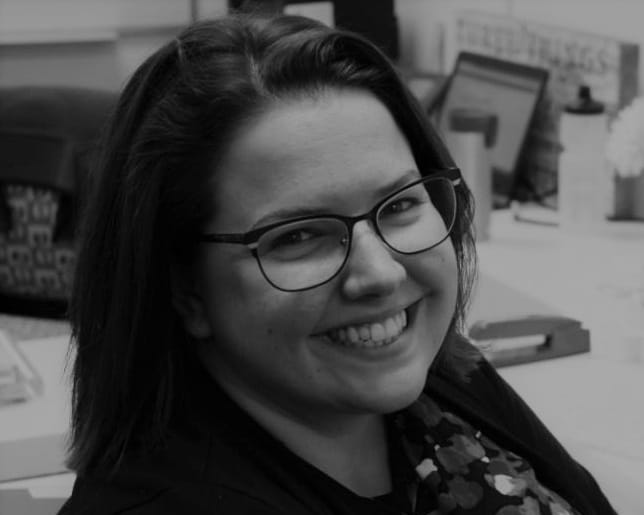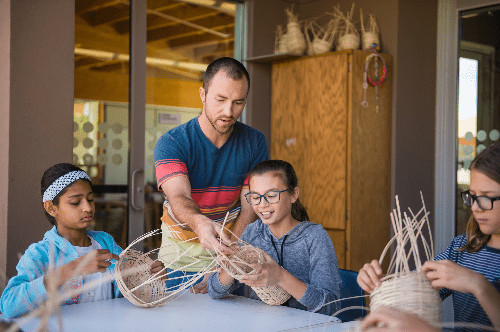Many public Montessori educators may not realize that they speak more than one language, but to be a Montessorian in the public sector is to be, inherently, bilingual.
Public Montessori teachers are charged with the unique task of mastering both the Montessori philosophy and curriculum while also aligning their instruction with academic content standards and district requirements. The responsibility of transitioning between worlds can feel daunting, especially for those new to the field.
But it can be done—and well. As public Montessori schools continue to multiply across the country, an increasing number of resources for public Montessori educators have emerged.
One of these resources is the National Center for Montessori in the Public Sector, a non-profit organization that supports equitable, accessible, and sustainable public Montessori programs.
NCMPS’s student support specialist, Maria Carvajal, believes that a big part of successfully implementing authentic Montessori education in America’s public schools comes down to mindset.
“We work to serve children that may not otherwise have the opportunity to attend a Montessori school, so we must figure out how to work within our districts. It’s about adapting and thinking strategically,” she explains.
Carvajal discusses the unique challenges faced by public Montessori educators, citing the need to view lesson planning through a skills-based lens, how to prepare children for standardized testing while maintaining the integrity of the Montessori curriculum, and the importance of seeking out mentors and supportive colleagues.
Approach Planning with a Skills-Based Lens
Carvajal suggests that public Montessori teachers shift their thinking when developing their scope and sequence. “When planning, ask yourself, ‘What are the skills that this material supports?’” she says.
She believes the shift to skills-based thinking is essential in translating teaching intentions from the Montessori albums to the public Montessori environment. It’s a lens that, when worn, makes it a lot easier to connect the dots between the Montessori materials and academic content standards.
“When we identify the skill, we can then look at the standards and see how they come together and how they align,” expands Carvajal.
Tracking your skills-based observations allows you to approach individual lesson planning based on the child’s individual strengths and district standards. Keeping records on how specific lessons align with the standards also allows you to work more efficiently. Whether you’re recording these connections directly into your Montessori albums or creating a spreadsheet depends on how you best learn and organize your teaching practices. The important part is to take the time to document your connections for easier prep in the future.
Translate Your Terminology
Montessori is a jargon-heavy field. It’s easy to forget that, to many, we’re speaking in a foreign language.
Carvajal explains that “in our training, we learn and speak of materials, but for general practice, it’s important to know that wherever we’re teaching, we have to be able to speak to the purpose and the skill. We have to be able to articulate the result that comes with using the material. We’re not always talking to other Montessori teachers.”
One strategy is to integrate appositives into your speech patterns:
- Instead of: We use the Golden Beads to teach addition.
- Try: We use the Golden Beads, a material that concretely demonstrates quantity and place value within the decimal system, to teach addition.
- Instead of: We use the Sandpaper Letters to teach letter-sound correspondence.
- Try: We use the Sandpaper Letters, a tactile material that combines the sounds of our alphabet with muscular and visual memory, to teach letter-sound correspondence.
Not only are we better serving our community when we communicate in a language understood by all, but the exercise in translation is an opportunity to deepen our understanding of both content standards and Montessori pedagogy. By doing so, we engage in an exercise that reminds us of the direct aims of our lessons and materials.
Carvajal elaborates:
“It is indispensable to reflect on what I am teaching and why. In the same way children create deeper meaning when they understand the why behind their work and classroom responsibilities, we, too, better understand our practice when we speak with non-Montessorians about our pedagogy. It takes us out of autopilot. It’s an excellent opportunity to further our professional growth as guides.”
Translating terminology is an exercise that’s worthwhile for all Montessori educators, not just those in public schools, and is particularly beneficial when speaking with parents and caregivers.
Follow the Child While Planning for High Stakes Testing
It’s arguably the greatest pain point for public school teachers: standardized testing. It’s inevitable, even for Montessori schools, but that shouldn’t deter teachers from staying true to the Montessori philosophy.
Carvajal suggests planning backwards.
Identify what concepts you will need to cover in preparation for testing, determine how many months you have leading up to the test date, and then look at the students as individuals, identifying what support they will each need to work towards abstraction.
She emphasizes that public school teachers should remain committed to individualized planning and pacing.
Carvajal shares her way of thinking when planning lessons:
“I say to myself, OK, I have six months. This is where the child is. This is where she needs to be. What middle steps can I make in the passage to abstraction without jumping directly to pencil and paper? Yes, I may need to adjust my timing, but it’s still possible to do.”
She also points out that much of the Montessori curriculum takes the child beyond the content standards, reminding public school teachers that they’re allowed to exceed the skills identified in district requirements.
Get to Know Your Neighbors
Carvajal remembers her early experiences teaching Montessori in a public charter school and credits her colleagues for much of her success.
“I quickly figured out which people in my building were good resources, and I often leaned on them,” she says.
It’s a good strategy for any teacher, especially those trying to navigate the complexities of reconciling the Montessori philosophy with public school guidelines.
Collaborate with other teachers in your building. Share ideas and resources. AMS also offers opportunities for members to join together online with other public and charter school teachers through the AMS Connect platform.
After all, borrowing a metaphorical cup of sugar from your neighbor can often be the start of a lifelong friendship.
About the Author
 |
Kira Hinkle (she/her) is a Montessori educator turned freelance writer. She is AMS credentialed (Elementary I). Contact her at kirahinkle@gmail.com. |
The opinions expressed in Montessori Life are those of the authors and do not necessarily represent the position of AMS.


